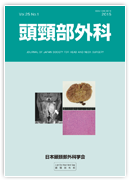Volume 25, Issue 1
Displaying 1-17 of 17 articles from this issue
- |<
- <
- 1
- >
- >|
-
2015Volume 25Issue 1 Pages 1-7
Published: June 30, 2015
Released on J-STAGE: July 31, 2015
Download PDF (335K) -
2015Volume 25Issue 1 Pages 9-14
Published: June 30, 2015
Released on J-STAGE: July 31, 2015
Download PDF (444K) -
2015Volume 25Issue 1 Pages 15-20
Published: June 30, 2015
Released on J-STAGE: July 31, 2015
Download PDF (1036K) -
2015Volume 25Issue 1 Pages 21-27
Published: June 30, 2015
Released on J-STAGE: July 31, 2015
Download PDF (516K) -
2015Volume 25Issue 1 Pages 29-33
Published: June 30, 2015
Released on J-STAGE: July 31, 2015
Download PDF (771K) -
2015Volume 25Issue 1 Pages 35-41
Published: June 30, 2015
Released on J-STAGE: July 31, 2015
Download PDF (602K)
-
2015Volume 25Issue 1 Pages 43-47
Published: June 30, 2015
Released on J-STAGE: July 31, 2015
Download PDF (724K) -
2015Volume 25Issue 1 Pages 49-53
Published: June 30, 2015
Released on J-STAGE: July 31, 2015
Download PDF (1006K) -
2015Volume 25Issue 1 Pages 55-60
Published: June 30, 2015
Released on J-STAGE: July 31, 2015
Download PDF (1172K) -
2015Volume 25Issue 1 Pages 61-65
Published: June 30, 2015
Released on J-STAGE: July 31, 2015
Download PDF (697K) -
2015Volume 25Issue 1 Pages 67-71
Published: June 30, 2015
Released on J-STAGE: July 31, 2015
Download PDF (1357K) -
2015Volume 25Issue 1 Pages 73-78
Published: June 30, 2015
Released on J-STAGE: July 31, 2015
Download PDF (1368K) -
2015Volume 25Issue 1 Pages 79-84
Published: June 30, 2015
Released on J-STAGE: July 31, 2015
Download PDF (921K) -
A case of thyroid cancer, resection of trachea and reconstructed tracheal wall with costal cartilage2015Volume 25Issue 1 Pages 85-89
Published: June 30, 2015
Released on J-STAGE: July 31, 2015
Download PDF (621K) -
2015Volume 25Issue 1 Pages 91-97
Published: 2015
Released on J-STAGE: July 31, 2015
Download PDF (1475K) -
2015Volume 25Issue 1 Pages 99-102
Published: June 30, 2015
Released on J-STAGE: July 31, 2015
Download PDF (490K) -
2015Volume 25Issue 1 Pages 103-107
Published: June 30, 2015
Released on J-STAGE: July 31, 2015
Download PDF (685K)
- |<
- <
- 1
- >
- >|
